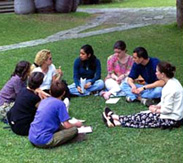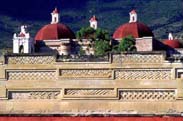|
Activities & Excursions - Oaxaca, Mexico
|
|
|
|
|
Intercambio/ Conversation Exchange
The intercambio is a conversation exchange in which students meet for one hour daily with native speakers to practice speaking Spanish. The conversation partners are university students or professionals who are eager to help students speak Spanish in exchange for a chance to practice their English language skills. The intercambio is a time for casual conversation and is an excellent opportunity to practice Spanish with someone who is interested in sharing information about Oaxaca with students. The intercambio is a popular feature of the Institute's language program and many intercambio partners form lasting friendships that continue after the student leaves Oaxaca.
|

|
|
|
|

|
Excursions
The Institute arranges weekend tours to various sites around the state of Oaxaca. These tours are optional and available at an additional cost. The Institute's bilingual guide takes students to archaeological sites, indigenous markets, artisan villages, and numerous other destinations where they will find opportunities to explore Mexican culture outside of the city of Oaxaca. These tours are designed to enrich student's understanding of Mexican art, indigenous life, and history, and are an excellent way to become acquainted with the splendors of the Oaxaca´s Central Valleys. Tours include the following destinations:
|
|
|
| |
•
Monte Alban: The largest archaeological site in the state of Oaxaca, Monte Alban is a Zapotec ceremonial center that experienced its splendor from 200-800 AD. The tombs found on this site are considered some of the richest and most extensive art finds in the world.
|
|
|
| |
•
Mitla: This archaeological site was originally a Zapotec burial ground, but was then conquered by the Mextecs in 1250 AD. It is renowned for its stone mosaics, Nahuatl codices, and Spanish chapel built from stones taken from the Mixtec buildings on the site.
|
|
|
| |
•
Tlacolula: This village is home to one of the largest indigenous markets in Mexico and is an excellent place to buy artesanias or simply watch Oaxacans make their weekly purchases. In addition to the colorful, bustling market, Tlacolula is famous for its cathedral.
|
|
|
| |
•
Tule: The massive 2000-year old Arbol de Tule is the largest cypress tree in the world and measures one hundred sixty-five feet in circumference.
|
|
|
| |
•
Teotitlan: This Zapotec village is world famous for its weavings. Students can observe weavers who still employ traditional techniques, including natural dyes and hand-carved woods, and continue incorporating traditional Zapotec designs in their woven rugs.
|
|
|
|
|
|
|
|
|

